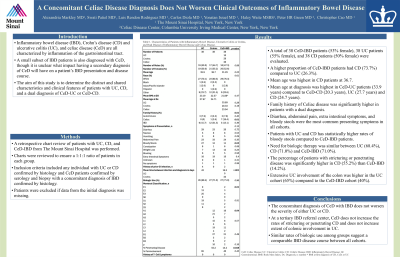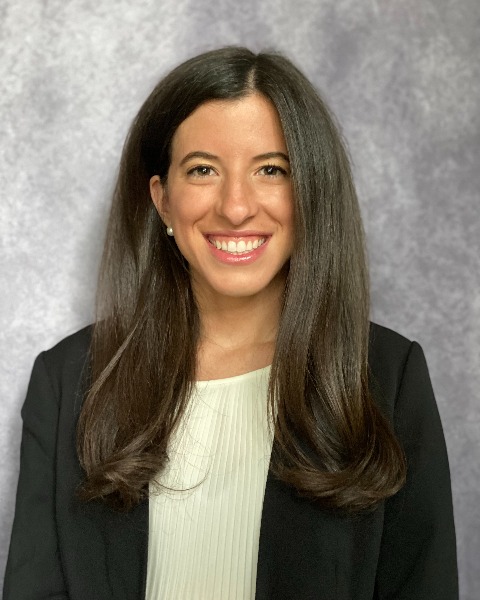Tuesday Poster Session
Category: IBD
P4327 - A Concomitant Celiac Disease Diagnosis Does Not Worsen Clinical Outcomes of Inflammatory Bowel Disease
Tuesday, October 29, 2024
10:30 AM - 4:00 PM ET
Location: Exhibit Hall E


Alexandria Markley, MD
Mount Sinai West, Icahn School of Medicine at Mount Sinai
New York, NY
Presenting Author(s)
Alexandria Markley, MD1, Swati Patel, MD2, Luis Rendon, MD3, Yontan Israel, MD4, Carlos Diola, MD4, Haley Waite, MS5, Peter Green, MD6, Christopher Cao, MD4
1Mount Sinai West, Icahn School of Medicine at Mount Sinai, New York, NY; 2Mount Sinai Morningside/West, Icahn School of Medicine at Mount Sinai, New York, NY; 3Mount Sinai Beth Israel, Icahn School of Medicine at Mount Sinai, New York, NY; 4Icahn School of Medicine at Mount Sinai, New York, NY; 5Mount Sinai Health System, New York, NY; 6New York-Presbyterian/Columbia University Irving Medical Center, New York, NY
Introduction: Inflammatory bowel disease (IBD), Crohn’s disease (CD) and ulcerative colitis (UC), and celiac disease (CeD) are all characterized by inflammation of the gastrointestinal tract. A small subset of IBD patients is also diagnosed with CeD, though it is unclear what impact having a secondary diagnosis of CeD will have on a patient’s IBD presentation and disease course. The aim of this study is to determine the distinct and shared characteristics and clinical features of patients with UC, CD, and a dual diagnosis of CeD-UC or CeD-CD.
Methods: A retrospective chart review of patients with UC, CD, and CeD-IBD from The Mount Sinai Hospital was performed. Charts were reviewed to ensure a 1:1:1 ratio of patients in each group. Inclusion criteria included any individual with UC or CD confirmed by histology and CeD patients confirmed by serology and biopsy with a concomitant diagnosis of IBD confirmed by histology. Patients were excluded if data from the initial diagnosis was missing.
Results: A total of 38 CeD-IBD patients (53% female), 38 UC patients (55% female), and 38 CD patients (50% female) were evaluated. A higher proportion of CeD-IBD patients had CD (73.7%) compared to UC (26.3%). Mean age was highest in CD patients at 36.7. Mean age at diagnosis was highest in CeD-UC patients (33.9 years) compared to CeD-CD (20.3 years), UC (27.7 years) and CD (24.7 years). Family history of Celiac disease was significantly higher in patients with a dual diagnosis. Diarrhea, abdominal pain, extra intestinal symptoms, and bloody stools were the most common presenting symptoms in all cohorts. Patients with UC and CD has statistically higher rates of bloody stools compared to CeD-IBD patients. Need for biologic therapy was similar between UC (68.4%), CD (71.0%) and CeD-IBD (71.0%). The percentage of patients with stricturing or penetrating disease was significantly higher in CD (55.2%) than CeD-IBD (14.2%). Extensive UC involvement of the colon was higher in the UC cohort (65%) compared to the CeD-IBD cohort (40%).
Discussion: The concomitant diagnosis of CeD with IBD does not worsen the severity of either UC or CD. At a tertiary IBD referral center, CeD does not increase the rates of stricturing or penetrating CD and does not increase extent of colonic involvement in UC. Similar rates of biologic use among groups suggest a comparable IBD disease course between all cohorts.
Note: The table for this abstract can be viewed in the ePoster Gallery section of the ACG 2024 ePoster Site or in The American Journal of Gastroenterology's abstract supplement issue, both of which will be available starting October 27, 2024.
Disclosures:
Alexandria Markley, MD1, Swati Patel, MD2, Luis Rendon, MD3, Yontan Israel, MD4, Carlos Diola, MD4, Haley Waite, MS5, Peter Green, MD6, Christopher Cao, MD4. P4327 - A Concomitant Celiac Disease Diagnosis Does Not Worsen Clinical Outcomes of Inflammatory Bowel Disease, ACG 2024 Annual Scientific Meeting Abstracts. Philadelphia, PA: American College of Gastroenterology.
1Mount Sinai West, Icahn School of Medicine at Mount Sinai, New York, NY; 2Mount Sinai Morningside/West, Icahn School of Medicine at Mount Sinai, New York, NY; 3Mount Sinai Beth Israel, Icahn School of Medicine at Mount Sinai, New York, NY; 4Icahn School of Medicine at Mount Sinai, New York, NY; 5Mount Sinai Health System, New York, NY; 6New York-Presbyterian/Columbia University Irving Medical Center, New York, NY
Introduction: Inflammatory bowel disease (IBD), Crohn’s disease (CD) and ulcerative colitis (UC), and celiac disease (CeD) are all characterized by inflammation of the gastrointestinal tract. A small subset of IBD patients is also diagnosed with CeD, though it is unclear what impact having a secondary diagnosis of CeD will have on a patient’s IBD presentation and disease course. The aim of this study is to determine the distinct and shared characteristics and clinical features of patients with UC, CD, and a dual diagnosis of CeD-UC or CeD-CD.
Methods: A retrospective chart review of patients with UC, CD, and CeD-IBD from The Mount Sinai Hospital was performed. Charts were reviewed to ensure a 1:1:1 ratio of patients in each group. Inclusion criteria included any individual with UC or CD confirmed by histology and CeD patients confirmed by serology and biopsy with a concomitant diagnosis of IBD confirmed by histology. Patients were excluded if data from the initial diagnosis was missing.
Results: A total of 38 CeD-IBD patients (53% female), 38 UC patients (55% female), and 38 CD patients (50% female) were evaluated. A higher proportion of CeD-IBD patients had CD (73.7%) compared to UC (26.3%). Mean age was highest in CD patients at 36.7. Mean age at diagnosis was highest in CeD-UC patients (33.9 years) compared to CeD-CD (20.3 years), UC (27.7 years) and CD (24.7 years). Family history of Celiac disease was significantly higher in patients with a dual diagnosis. Diarrhea, abdominal pain, extra intestinal symptoms, and bloody stools were the most common presenting symptoms in all cohorts. Patients with UC and CD has statistically higher rates of bloody stools compared to CeD-IBD patients. Need for biologic therapy was similar between UC (68.4%), CD (71.0%) and CeD-IBD (71.0%). The percentage of patients with stricturing or penetrating disease was significantly higher in CD (55.2%) than CeD-IBD (14.2%). Extensive UC involvement of the colon was higher in the UC cohort (65%) compared to the CeD-IBD cohort (40%).
Discussion: The concomitant diagnosis of CeD with IBD does not worsen the severity of either UC or CD. At a tertiary IBD referral center, CeD does not increase the rates of stricturing or penetrating CD and does not increase extent of colonic involvement in UC. Similar rates of biologic use among groups suggest a comparable IBD disease course between all cohorts.
Note: The table for this abstract can be viewed in the ePoster Gallery section of the ACG 2024 ePoster Site or in The American Journal of Gastroenterology's abstract supplement issue, both of which will be available starting October 27, 2024.
Disclosures:
Alexandria Markley indicated no relevant financial relationships.
Swati Patel indicated no relevant financial relationships.
Luis Rendon indicated no relevant financial relationships.
Yontan Israel indicated no relevant financial relationships.
Carlos Diola indicated no relevant financial relationships.
Haley Waite indicated no relevant financial relationships.
Peter Green indicated no relevant financial relationships.
Christopher Cao indicated no relevant financial relationships.
Alexandria Markley, MD1, Swati Patel, MD2, Luis Rendon, MD3, Yontan Israel, MD4, Carlos Diola, MD4, Haley Waite, MS5, Peter Green, MD6, Christopher Cao, MD4. P4327 - A Concomitant Celiac Disease Diagnosis Does Not Worsen Clinical Outcomes of Inflammatory Bowel Disease, ACG 2024 Annual Scientific Meeting Abstracts. Philadelphia, PA: American College of Gastroenterology.
